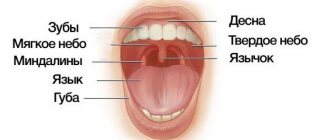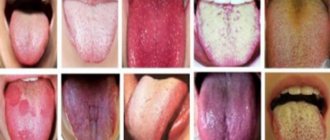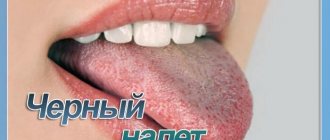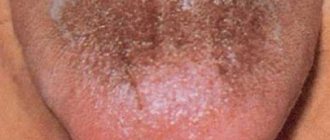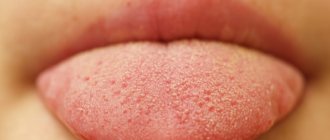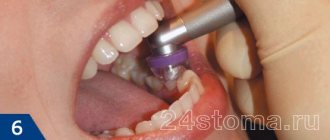Human language is a kind of indicator of the organism. If suddenly any organ “fails,” it will definitely notify its owner about this by changing color.
Every day a small amount of plaque appears on the tongue and this is normal. It is caused by the activity of bacteria and disappears after each cleaning. If the taste organ changes its color and becomes, for example, blue, the alarm should be sounded. This color can signal possible malfunctions in the functioning of vital organs. It’s good if this is the initial stage of the disease. A timely visit to a doctor will help get rid of the disease faster and easier.
Why does the tongue change color?
Normally, the human tongue should be light pink in color with a thin layer of light coating. A change in color indicates that there is some kind of malfunction in the body. Thanks to this ability of the tongue, it has become easier for doctors to diagnose a particular disease.
READ IN DETAIL: human tongue: the color of a healthy organ and the reasons for its change
What can the different colors of the tongue tell us? So:
- pale pink shade - a person is absolutely healthy,
- white means that the body has problems with the intestines or stomach, possible fungal infection, colds, ARVI or dehydration (the initial stage of the disease),
- gray warns of chronic gastrointestinal disease,
- blue tongue - may mean that there are serious kidney problems, cyanosis, anemia or rhomboid glossitis,
- yellow - indicates disturbances in the functioning of the gallbladder, gastrointestinal tract, serious liver disease; this color of the tongue most often occurs in people who smoke (we recommend reading: what does it mean if there is a yellow coating on the tongue?),
- light red - indicates the presence of an infection or inflammatory process in the body,
- raspberry means a decrease in hemoglobin levels,
- bright red - blood diseases, disorders of the cardiovascular system,
- burgundy - signals an acute infectious disease,
- blue or purple - indicates problems with the heart and lungs,
- green - exacerbation of disease of the stomach or duodenum, disruption of the gallbladder,
- dirty gray - signals an inflammatory process in the abdominal cavity,
- brown - serious problems with the digestive system,
- black - is a sign of dehydration, acidosis, pancreatic diseases.
If the tongue darkens over time, this indicates that the person’s condition is deteriorating. A colorless tongue occurs in those who suffer from vitamin deficiency, anemia, or have an unhealthy diet. Very dark indicates the presence of acute chronic diseases that need to be treated urgently.
Diagnostics
Consultation with a specialist is necessary for diagnostic studies and treatment. To get advice, you need to contact a therapist or pediatrician, who, if necessary, will refer you to:
- dentist;
- gastroenterologist;
- endocrinologist;
- infectious disease specialist;
- hematologist;
- dermatologist.
A detailed diagnosis will help you understand why a person’s tongue has turned blue or purple:
- Blood analysis. General analysis to determine hemoglobin, ESR, band cells. Biochemical analysis with determination of bilirubin, liver enzymes, creatinine, protein fractions. Serological blood tests for ELISA of syphilis, hepatitis. Blood test for Helicobacter antibodies, which cause gastritis.
- Coprology, stool analysis for helminthic infestations and other parasites.
- Bacteriological culture of a smear from the tongue. Sowing allows you to determine the microflora that caused the pathology, its sensitivity to antibiotics, and quantity. Also, feces and urine are taken for bacteriological culture.
- Ultrasound of the abdominal cavity, kidneys, pelvic organs.
- FGDS. Endoscopic examinations of the upper gastrointestinal tract.
- ECG. Determines the functional state of the heart, pathological changes.
Treatment of pathological processes is prescribed after finding the cause.
Causes of blue plaque with photos
Why did the taste organ suddenly turn blue (see photo)? Only specialists can answer this question after a complete examination of the body. Looking ahead, we can say that a person may have the following problems:
- Cyanosis is a decrease in oxygen levels in the blood, which causes the skin and mucous membranes to acquire a bluish tint.
- Anemia - the body suffers from a lack of folic acid, iron and vitamin B12. This leads to a blue tongue and pale skin.
- Diamond-shaped glossitis - the base of the tongue becomes dense and turns blue. The disease is asymptomatic. It is typical for men who have considerable experience as smokers.
- Food coloring - if the tongue quickly and spontaneously changes color to normal.
- Cardiovascular failure. This color of the tongue indicates this problem long before the first signs of the disease appear. If the blue color is localized in the lower part of the tongue, then this is a sign of circulatory disorders, which is aggravated by cardiopulmonary failure.
- Renal failure (pathology of the kidneys with impaired formation and excretion of urine) - with this disease, the taste organ at the edges in front of the pharynx becomes cyanotic.
- Poisoning with mercury or other heavy metals.
- Inflammatory process in the abdominal cavity - may be accompanied by an increase in body temperature and pain in the abdominal area.
READ IN DETAIL: How does the color of the tongue change during diseases?
Therapeutic diet
Regardless of what the cause of the cyanotic organ of taste is, the first thing you need to do is normalize your diet. The following should be excluded from the diet:
- food from fast foods,
- fatty meats (lamb, pork, duck),
- spicy and salty,
- marinades and smoked meats,
- carbonated drinks,
- alcoholic drinks,
- flour and sweet,
- mushrooms.
You need to eat often, but little by little. Make sure that the intestines are emptied in a timely manner. You need to drink at least two liters of still water per day.
The diet menu should include the following products:
- vegetables (except legumes),
- lactic acid,
- vegetarian soups,
- porridge (wheat, rice, buckwheat),
- non-sour fruits and berries,
- dietary meat (rabbit, turkey, chicken breast).
Treatment methods
A blue coating on the tongue can be removed only after the exact cause of the change in its color has been determined. A gastroenterologist, dentist or family doctor will help you find out the reason. Only after examination by specialists, medical history and additional laboratory tests can appropriate treatment be selected.
It is also important to know that the tongue is visually divided into certain zones, which, by changing color, accurately indicate health problems in a particular organ. For example, the tip of the tongue is considered the upper part of the body, and the root is considered the lower part. Depending on which part of it the cyanosis is observed, one can judge the nature of the disease. The table below shows a map of the language.
| Tongue area | What organs belong to it? |
| The tip turned blue | There are problems with the functioning of the heart and lungs. |
| Horizontal part of the middle of the tongue | Indicates that the stomach, spleen, liver and pancreas need to be examined urgently. |
| Blue root | The intestines require urgent cleansing of toxins and taking prebiotics. |
| Blue sides of tongue | The function of the kidneys and urine excretion pathways is impaired. |
| The middle of the tongue is the vertical part | There are serious problems with the spine. |
Depending on the location, a blue coating on the tongue may indicate a disease of a particular organ.
The saturation of the blue color will also help to make a more accurate diagnosis:
- blue-violet tongue – heart failure;
- cyanosis of the oral mucosa – cyanosis;
- light blue tint in the center – anemia;
- bluish tint – blood circulation is impaired;
- blue-black spots – problems with the adrenal glands;
- blue-blue or blue-violet tint – pathologies of the blood and lungs.
If the cause of your blue tongue is the wine you drank, then don’t worry, the problem will disappear on its own, just brush your teeth and tongue.
A blue coating on the tongue is a symptom of coronavirus, but you need to remember that there is no vaccine for this disease. If an illness is detected, then urgent self-isolation and calling a health worker at home is necessary. To reduce high fever and relieve pain, take Paracetamol.
But you should not overdo it with it, as this drug has a toxic effect. They fight the symptoms of coronavirus with drugs to strengthen the immune system, proper nutrition and active physical activity.
Antibiotics
If it is determined that the cause of the blue tongue is related to the digestive system, then the specialist may recommend taking antibiotics, for example, Amoxicillin. This is an antimicrobial agent from the penicillin group. It is a broad-spectrum drug that effectively fights the bacterium Helicobacter pylori.
The drug is available in the form of granules, capsules, suspensions and tablets. The drug is indicated for infectious lesions of the digestive organs; it destroys bacterial cells and leads to their death. The course and dosage are selected individually.
Antispasmodics
Antispasmodics, for example, No-Shpa, may also be recommended. It affects smooth muscle cells and does not penetrate the brain. With their help, it is possible to stop the flow of calcium ions and some enzymes, thereby stopping muscle contraction.
Novigan
Novigan is a drug available in tablet form, which is recommended for use for renal and intestinal colic. This drug can harm people with serious intestinal diseases and is contraindicated for heart, kidney and liver diseases.
For vitamin deficiency, taking vitamins is recommended, and they should also be present in the daily diet.
Anti-inflammatory drugs
Anti-inflammatory drugs will help relieve inflammation in the digestive organs and abdominal cavity. Among the effective drugs, Mezavant and Salosinal can be distinguished.
Immunomodulators are also important, which are additionally prescribed for the inflammatory process. Medicines such as Viferon and Immunal are suitable. You can also use natural ingredients. So, for example, take 40 drops of alcohol tincture of Echinacea or Eleutherococcus every day.
Traditional methods
The blue coating observed on the tongue also accepts the use of traditional medicine. Decoctions and infusions of medicinal herbs are recommended for rinsing the mouth.
You can use the following recipes:
| Chamomile flowers | You need to take 1 tbsp. l. dry raw materials, pour 1 tbsp. boiling water, leave for 40 minutes. let it brew, then strain and rinse your mouth twice a day. | Duration of therapy is 10-14 days. |
| Calendula flowers | The decoction should be prepared as follows: take 1 tbsp. l. dried calendula flowers, pour 1 tbsp. cold water and place in a water bath, wait for the liquid to boil. Cool the broth, strain and rinse the mouth after each meal. | The duration of therapy lasts until the cyanosis disappears from the tongue. |
| Cinnamon and cloves | Take 5 buds of cloves and ½ tbsp. l. cinnamon powder, pour all 1 tbsp. boiling water and leave for 20 minutes. brew. Rinse your mouth while the mixture is warm. | Duration of therapy is 10 days. |
Diet
There are many reasons that provoke a bluish tint. Treatment is selected after identifying the cause, but before you start taking medications you need to change your diet.
First of all, you should exclude the following products:
- fast foods;
- fatty meats;
- nothing spicy or salty;
- remove marinades and smoked meats;
- completely eliminate carbonated drinks and alcohol-containing drinks;
- no mushrooms;
- as little flour and sweet as possible.
You need to eat up to 6 times a day, in small portions. Give preference to fresh vegetables and fruits, more lean meat, but better baked or boiled. Be sure to consume porridge and fermented milk products.
A blue tongue is the first sign that you need to sound the alarm and seek help from a specialist. Plaque on the tongue can be easily cleared with medicinal decoctions and brushing with a toothbrush, but this will not remove the cause and the cyanosis will soon reappear. Only eliminating the causes of such plaque will help prevent serious complications.
Ways to clean your tongue
To clean your tongue from plaque, a regular toothbrush will do. It can even be without a special rough lining, which is designed to care for the tongue. You can do without it. It is enough to take a medium-hard brush and walk the bristles from the root of the tongue to the lips, using antibacterial paste.
READ ALSO: Rough tongue: causes and solutions You can use a scraper specially designed for this purpose as a device for cleaning the tongue. It can be plastic, wood or metal. Some specimens also have special brushes. Tongue hygiene procedures should be carried out immediately after brushing your teeth. You need to move the scraper from the root of the tongue, gradually moving towards its end. First, the side with the brush is used, and then its hard side is used, with the help of which the tongue is massaged.
If you don’t have a brush or scraper at hand, you can use, for example, a teaspoon, a bandage wrapped around your finger, a clean towel or a textile napkin.
If after these procedures the plaque appears again, you can try the following traditional methods:
- Rinse your mouth with herbal infusions, which normalize the microflora in the mouth and eliminate the causes of plaque (we recommend reading: white coating on the tongue: causes, photos and treatment). To do this, you need to pour boiling water over the herbs (chamomile, mint, sage, calendula, oak bark) and leave for about an hour.
- Every morning before meals, take a decoction of flaxseed, which has a positive effect on digestion.
- Rinse your mouth with vegetable oil three times a day. The procedure must be done for at least 20 minutes and then spat out. One spoon of oil will be enough. After this, the mouth should be rinsed with water.
Prevention of plaque formation
To ensure that your tongue has a healthy color and is not covered with a thick layer of plaque, the following prevention must be carried out:
- after each brushing of your teeth, thoroughly clean the entire surface of the tongue (both horizontally and on the sides) using specially designed brushes and products that you can choose to your taste,
- rinse your mouth every time after eating,
- Visit your dentist annually for a professional oral examination,
- do not drink or eat too hot,
- quit smoking.
( 1 ratings, average: 4.00 out of 5)
Associated symptoms of pathology
If the organ necessary for conversation acquires a specific tone, then most often the baby will additionally exhibit the following symptoms:
- Swelling in the mouth and face;
- Specific secretions;
- The presence of cracks, weeping ulcers;
- Soreness in the mouth when talking or eating;
- There are pimples, growths, and bumps on the surface.
If, when sticking out your tongue, not only a blue tone is visible, but also additional signs of illness, such as an unpleasant odor, then it is recommended to immediately consult a pediatrician. There is no need to prolong the baby’s condition until it becomes critical. It is better to start treatment at the first symptoms.



